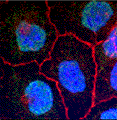Biochemistry, Department of
Studies of the CobA-Type ATP:Co(I)rrinoid Adenosyltransferase Enzyme of Methanosarcina mazei Strain Gõ1
Document Type
Article
Date of this Version
5-2006
Citation
Studies of the CobA-type ATP:Co(I)rrinoid Adenosyltransferase enzyme of Methanosarcina mazei strain Gö1. J. Bacteriol. 188: 3543-50. PMID: 16672609.
Abstract
Although methanogenic archaea use B12 extensively as a methyl carrier for methanogenesis, little is known about B12 metabolism in these prokaryotes or any other archaea. To improve our understanding of how B12 metabolism differs between bacteria and archaea, the gene encoding the ATP:co(I)rrinoid adenosyltransferase in Methanosarcina mazei strain Gö1 (open reading frame MM3138, referred to as cobAMm here) was cloned and used to restore coenzyme B12 synthesis in a Salmonella enterica strain lacking the housekeeping CobA enzyme. cobAMm protein was purified and its initial biochemical analysis performed. In vitro, the activity is enhanced 2.5-fold by the addition of Ca2+ions, but the activity was not enhanced by Mg2+and, unlike the S. enterica CobA enzyme, it was >50% inhibited by Mn2+. The CobAMm enzyme had a KmATPof 3 μM and a KmHOCblof 1 μM. Unlike the S. enterica enzyme, CobAMm used cobalamin (Cbl) as a substrate better than cobinamide (Cbi; a Cbl precursor); the β phosphate of ATP was required for binding to the enzyme. A striking difference between CobASe and CobAMm was the use of ADP as a substrate by CobAMm, suggesting an important role for the γ phosphate of ATP in binding. The results from 31P-nuclear magnetic resonance spectroscopy experiments showed that triphosphate (PPPi) is the reaction by-product; no cleavage of PPPi was observed, and the enzyme was only slightly inhibited by pyrophosphate (PPi). The data suggested substantial variations in ATP binding and probably corrinoid binding between CobASe and CobAMm enzymes.



Comments
Copyright © 2006 ASM
Link to PMC holding: https://www.ncbi.nlm.nih.gov/pmc/articles/PMC1482872/pdf/0088-06.pdf